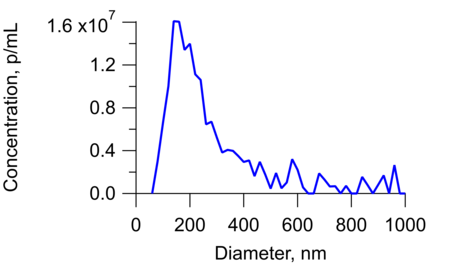Particle Size Analysis of Viruses and Virus-Like Particles
A virus particle consists of several parts including the genetic material (DNA or RNA), a protein coat that protects these genes, and in some cases an envelope of lipids that surrounds the protein coat when they are outside a cell. The size of viruses ranges from a few tens to a few hundreds of nm, which is equal to 1/100 to 1/1000 of the cell (a few to a few tens of μm in size) of any other common living organism. Influenza vaccines are now produced by growing the virus in fertilized eggs, then multiplying and inactivating it. The picture below is an electron micrograph of an influenza virus.

Image of an influenza virus.
Virus-like particles (VLP) are meant to mimic the virus of interest in everything except the genetic material. Due to this similarity (particular in terms of conformation) VLPs prove useful in the study of virus behavior and also vaccine development. The size of VLPs is similar to that of viruses and may be measured using either dynamic light scattering or laser diffraction technologies. The ability of laser diffraction to measure from nanometers to thousands of microns makes it well suited for VLP development. Depending on how the VLP is manufactured it's possible that fragments of starting material will be present in the sample at larger sizes than the VLP itself. The size of these particles can either be too large for dynamic light scattering to measure or present a difficult challenge for the lower resolution of that technique.
Size of Viruses using Dynamic Light Scattering
The SZ-100V2 Nanoparticle Analyzer has been successfully applied to analyze transparent bioparticles, such as influenza viruses and vaccines, with good accuracy. The particle diameter of any bioparticle determined by dynamic light scattering is usually larger than that from an electron micrograph. The reason for this is that hydrates and proteins around the cell move together, causing the particle to meet with resistance, which in turn causes DLS measurements to yield a larger particle size.
The result below for an influenza virus reported a mean size of 127.6 nm, with good repeatability. The measurement was made in the standard glass cell at the 90 degree scattering angle.

Particle size distribution for an influenza virus as measured by the SZ-100.

Size results for the influenza virus.
Size of Virus-Like Particles using Laser Diffraction
The LA-960V2 Particle Size Analyzer measuring range stretches from 10 nanometers to 5 millimeters. This is more than sufficient to measure virus-like particle samples -- including those containing material larger than several microns. An example size result (below) shows three separate populations. The finest population is the VLP itself. The LA-960 can report size metrics for the entire population as well as metrics for each individual population using the Multimodal Report.

Particle size distribution and results for a VLP material as measured by the LA-960.
Size of Virus and Virus-Like Particles using multi-laser Nanoparticle Tracking Analysis (m NTA)
The inherent difficulty of characterizing virus or VLP is that viruses undergo extensive compositional and expressional changes during infection. They may be whole, fragmented, or they may form complexes with impurities or aggregations. Whether your application is vaccines manufacturing, therapeutic and imaging agents, or virus research, to accurately count and size virus or VLP particle in any given sample set, we must consider the overall sample polydispersity. The ViewSizer 3000 multi-laser Nanoparticle Tracking Analyzer uses three simultaneous operating solid-state lasers with independently adjustable laser power to effectively capture viral particles of the entire size range.
Below is a measurement result of a human viral vector sample using the ViewSizer 3000. As shown, the particles within the sample exhibit a much broader size distribution beyond that expected from a perfectly purified homogeneous viral preparation. Particle sizes ranged from 50 nm to 1000 nm, with a significant enrichment of particles around 200 nm. The total viral particle concentration within the sample was 1.6E7 particles/mL. Note the distribution displayed presence of host cell debris and aggregates.

Measurement result of a human viral vector sample using the ViewSizer 3000.
Summary
The HORIBA SZ-100, LA-960, and ViewSizer 3000 particle size analyzers can measure the size of viruses and virus-like particles quickly and accurately. Additionally, the SZ-100 can measure the zeta potential of these materials.


